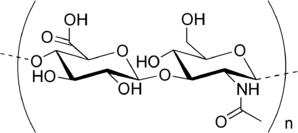
HA and Wound Repair
Our skin, delicate as it may seem, actually works as a barrier to protect us from infection and disease. When our skin is injured, the tissues that lie beneath it are exposed to external threats, setting off a sequence of processes, all of which work to rapidly heal and reconstruct the important barrier. The sequence is made up of several complex processes, known as the stages of wound healing:
- Inflammatory stage – the body reacts to a wound by forming a clot through contracting the blood vessels in the wound bed. This is also known as haemostasis, after which the blood vessels dilate allowing antibodies, growth factors, nutrients, and white blood cells to reach the injury. Any loose or necrotic tissue is broken down and removed from the wound to allow the next stage of healing to begin.
- Proliferation stage – the granulation tissue is rebuilt with new blood vessels in a process that is called angiogenesis. The success of this stage is dependent on cells getting enough oxygen and nutrients from the blood vessels. Epithelialisation is the final process of this stage and refers to the new layer of tissue that forms and creates a new surface on the wound.
- Maturation stage – this is the final stage of wound healing, in which the cellular activity reduces and the remodeling of collagen from type III to type I aid in closing the wound. Also, the amount of blood vessels in the injured area decrease during this stage.
Hyaluronic acid, though always present in the skin tissue, increases when an injury occurs to the skin and plays a role in all the stages of wound healing. HA promotes inflammation which is a crucial part of the wound healing process; a high abundance of HA is also found in granulation tissue matrix which, along with HA’s pro-inflammatory function, make it an integral part of the proliferation stage; and HA has also been found to play a crucial role in the final phases of wound healing because of its function in the re-epithelisation process, including working as a free-radical scavenger and manipulator of keratinocyte proliferation.
All of these functions are what makes HA able to speed up the healing process. Although we have known for decades that the presence of HA increases during the wound-healing process, it is only more recently that it’s been manufactured and applied to accelerate the healing of different types of wounds including burns, chronic wounds, and epithelial surgical wounds. HA is now manufactured in several forms, including gels, sheets, and meshes for epidermal engraftment.
Sources:
Hyaluronate Sodium in the ChemIDplus A Toxnet Database, accessed on May 23, 2014, from:
http://chem.sis.nlm.nih.gov/chemidplus/direct.jsp?regno=9067-32-7
Torvard C. Laurent, Robert E. Fraser. Hyaluronan. FASEB Journal – Federation of American Societies for Experimental Biology. Retrieved on April 17, 2014, from
http://www.fasebj.org/content/6/7/2397.full.pdf
Phases of Wound Healing. CliniMed Group. Retrieved on April 17, 2014, from
http://www.clinimed.co.uk/Wound-Care/Education/Wound-Essentials/Phases-of-Wound-Healing.aspx
Voigt J, Driver VR. (May 2012). Hyaluronic acid derivatives and their healing effect on burns, epithelial surgical wounds, and chronic wounds: a systematic review and meta-analysis of randomized controlled trials. PubMed. Retrieved on April 17, 2014, from
http://www.ncbi.nlm.nih.gov/pubmed/22564227
 Order Repagyn® Online
Order Repagyn® Online Print Coupons
Print Coupons




